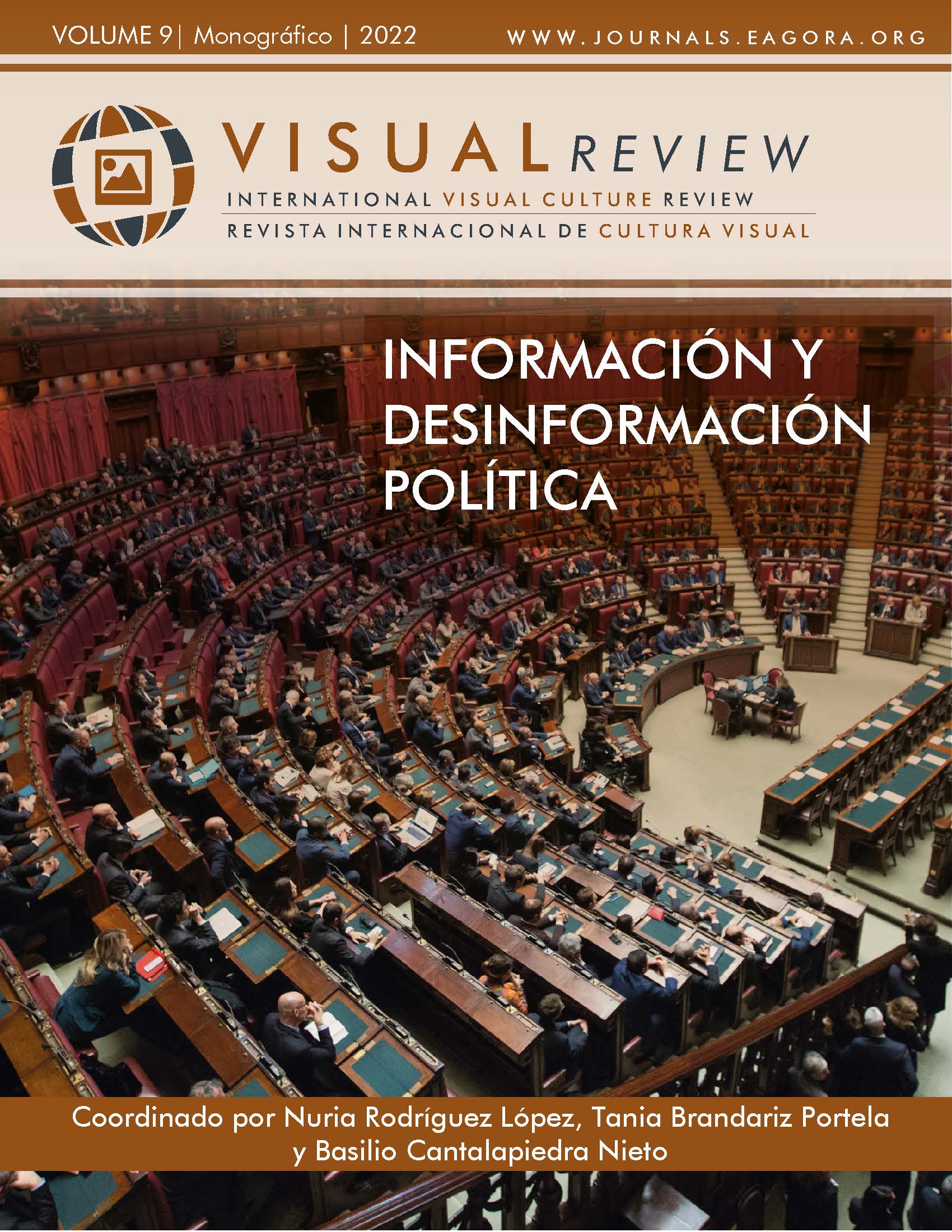The story battle in the Ukraine war
From televised speeches to video selfies
DOI:
https://doi.org/10.37467/revvisual.v9.3541Keywords:
Storytelling, Story battle, Ukraine war, Vladímir Putin, Volodímir Zelenski, Narrative analysis, Hybrid warAbstract
History has shown that conflicts are not only waged on the ground in various theatres of operations, but also in a symbolical manner too, those scenarios where non-conventional combat strategies are used to win, in this case, the battle of the story. This is notable in a technological and communicative context, defined by hyper connectivity. In this context, we have made a narrative analysis of the war stories between Russia and Ukraine, based on the speeches of their respective presidents, to conclude that the two leaders have built an emotional story, using storytelling techniques.
Downloads
Global Statistics ℹ️
|
817
Views
|
749
Downloads
|
|
1566
Total
|
|
References
Barthes, R. (1981). Introducción al análisis estructural de los relatos. Ediciones Coyoacán.
Cárdenas Ruiz, J. D. (2013). Storytelling y márquetin político: humanidad y emociones en la búsqueda de la visibilidad legitimada. Poliantea, 9(16), 33-50. https://dx.doi.org/10.15765/plnt.v9i16.392 DOI: https://doi.org/10.15765/plnt.v9i16.392
Charaudeau, P. (2009). La argumentación persuasiva. El ejemplo del discurso político. En M. Shiro, P. Bentivoglio & F. D. Erlich (Eds.) Haciendo discurso. Homenaje a Adriana Bolívar (pp. 277-295). Fondo Editorial de Humanidades de la Universidad Central de Venezuela. https://bit.ly/2JbgHa1
Coffey, A., & Atkinson, P. (2003). Encontrar el sentido a los datos cualitativos. Editorial Universidad de Antioquia.
Consejo de Seguridad Nacional de España (2021). Estrategia de Seguridad Nacional 2021. https://www.dsn.gob.es/es/documento/estrategia-seguridad-nacional-2021
Denning, S. (2008). Storytelling. En R. A. Couto (Ed.) Political and civic leadership: a reference handbook (pp. 830-837). SAGE Publications. https://dx.doi.org/10.4135/9781412979337.n93 DOI: https://doi.org/10.4135/9781412979337.n93
Estupiñán Mojica, J., & González Gutiérrez, O. (2015). Narrativa conversacional, relatos de vida y tramas humanos. Universidad Santo Tomás. DOI: https://doi.org/10.2307/j.ctvb6v71x
Gallardo Paúls, B. (2014). Usos políticos del lenguaje. Un discurso paradójico. Anthropos Editorial.
Giglioli, P. P. (2005). Invito allo studio della società. Il Mulino.
Guber, P. (2011a). Storytelling para el éxito. Conecta, persuade y triunfa gracias al poder de las historias. Empresa Activa.
Guber, R. (2011b). La etnografía: método, campo y reflexividad. Siglo XXI Editores Argentina.
Gutiérrez-Rubí, A. (2009). Micropolítica. Ideas para cambiar la comunicación política. Auto-ed. https://bit.ly/3QTzAPh
Fryer, B. (2003). Storytelling that moves people. Harvard Business Review, June, https://hbr.org/2003/06/storytelling-that-moves-people
Lakoff, G., & Johnson, M. (2021). Metáforas de la vida cotidiana. Cátedra.
López Mejía, D. I., Valdovinos de Yahia, A., Méndez-Díaz, M., & Mendoza-Fernández, V. (2009). El sistema límbico y las emociones: empatía en humanos y primates. Psicología Iberoamericana, 17(2), 60-69. https://bit.ly/3BjvMBz DOI: https://doi.org/10.48102/pi.v17i2.270
Lovecky, D. V. (2004). Different minds. Gifted children with AD/HD, Asperger Syndrome and others learning deficits. Jessica Kingsley Publishers.
Maarek, P. J. (2014). Politics 2.0: New Forms of Digital Political Marketing and Political Communication”. Trípodos, 34, 13-22. https://bit.ly/3Pa47qP
McAllister, I. (2007) The personalization of politics. En R. J. Dalton & H. D. Klingemann (Eds.) The Oxford handbook of political behavior (pp. 571-588). Oxford University Press. http://dx.doi.org/10.1093/oxfordhb/9780199270125.003.0030 DOI: https://doi.org/10.1093/oxfordhb/9780199270125.003.0030
Navarro Romero, R. M., & Gómez Alonso, J. C. (2017). Vigencia de las categorías de la Retórica en la cultura audiovisual. Bajo Palabra, 14, 83-94. http://dx.doi.org/10.15366/bp2017.14 DOI: https://doi.org/10.15366/bp2017.14
Neuman, W. L. (2014). Social research methods: qualitative and quantitative approaches. Pearson Education.
Núñez, A. (2010). ¡Será mejor que lo cuentes! Los relatos como herramientas de comunicación. Storytelling. Empresa Activa.
Ricoeur, P. (1989). “La fragilidad del lenguaje político”. Signo y Pensamiento, 15, 33-43. https://bit.ly/3zsCaF0
Riessman, C. K. (2008). Narrative methods for the human sciences. SAGE Publications.
Rodríguez Suárez, L. P. (2008). Sobre el origen de la comunicación persuasiva (una propuesta desde la filosofía de la comunicación de Heidegger). Stvdivm, Revista de Humanidades, 14, 89-98. https://bit.ly/3b3gRAB
Salmon, C. (2008). Storytelling. La máquina de fabricar historias y formatear mentes. Península.
Solares Altamirano, B. (2006). Aproximaciones a la noción de imaginario. Revista Mexicana de Ciencias Políticas y Sociales, (48)198, 129-141. http://dx.doi.org/10.22201/fcpys.2448492xe.2006.198.42543 DOI: https://doi.org/10.22201/fcpys.2448492xe.2006.198.42543
Vázquez Sande, P. (2017). Personalización de la política, storytelling y valores transmitidos. Communication & Society, 30(3), 275-291. https://hdl.handle.net/10171/43935 DOI: https://doi.org/10.15581/003.30.35775
Downloads
Published
How to Cite
Issue
Section
License
Those authors who publish in this journal accept the following terms:
-
Authors retain copyright.
-
Authors transfer to the journal the right of first publication. The journal also owns the publishing rights.
-
All published contents are governed by an Attribution-NoDerivatives 4.0 International License.
Access the informative version and legal text of the license. By virtue of this, third parties are allowed to use what is published as long as they mention the authorship of the work and the first publication in this journal. If you transform the material, you may not distribute the modified work. -
Authors may make other independent and additional contractual arrangements for non-exclusive distribution of the version of the article published in this journal (e.g., inclusion in an institutional repository or publication in a book) as long as they clearly indicate that the work was first published in this journal.
- Authors are allowed and recommended to publish their work on the Internet (for example on institutional and personal websites), following the publication of, and referencing the journal, as this could lead to constructive exchanges and a more extensive and quick circulation of published works (see The Effect of Open Access).













